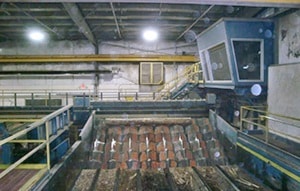Monday was Canfor’s last sawmill production day with the planer mill slated to finish a few days later. This closure is in line with B.C.’s forest industry’s downward trajectory as the mountain pine beetle and other pressures on the industry take their toll.
Between 2005 – 2012, 23 mills have shut their doors because of various factors, including lack of mill profitability, rationalization of mill assets, catastrophic fires and reduced log supply.
Quesnel Canfor cites fibre supply as the primary reason for closing the facility.
This plant produced about 240 million board feet annually, about 5 – 6 per cent of Canfor’s western operations, which has an annual production capacity of 4.5 billion board feet.
“All the wood produced in Quesnel went to China and we are re-allocating production to fill those costumers’ needs,” Mark Feldinger, Canfor senior vice president of energy, environment, transportation and sourcing said.
Of the closure, Feldinger said they agreed to swap tenure with West Fraser Mills to acquire cutting licences in the Maurice Timber Supply Area near Houston, where West Fraser Mills will close its mill. This allows each mill to have the necessary fibre for operations.
Feldinger said Canfor expects more of this type of activity as the mountain pine beetle effects are felt through the industry in B.C.’s north.
“They’re salvaging dead wood,” he said.
As the number of years progress after a forest is killed, the wood fibre of the dead forest gets drier and more brittle and then starts to rot at the base of the tree.
This has a negative impact on both costs and revenues.
‘Over the next 6 – 8 years, we anticipate another 5 – 6 facilities in the Northern Interior will be closing, including ongoing stresses in Quesnel,” Feldinger said.
“It will probably be 50 – 60 years before the timber supply rejuvenates.”
The Canfor site has been a sawmill for 55 years and that’s the sort of turnaround we predict, he added.
With the workers filing out for the last time this week, Canfor’s Christine Kennedy, vice president of brand and public affairs said the company would be moving forward with the sale of the facility.
Some equipment will be salvaged for other mills and the company is storing current inventory in the facility, however, once that’s gone the remainder will be up for sale.
“Mayor Mary Sjostrom has encouraged expediency on the sale as soon as possible for repurposing the facility for other uses,” Kennedy said.
“Right from the beginning when we announced the closure, our first commitment was the employees. We are also committed to keeping programs and projects that we have supported such as scholarships and dry grad for the years ahead.
“We are still committed to the community despite closure of our facility.”
Of the 209 employees whose jobs were terminated with the closure, 39 have remained with the company in other operations, 62 have chosen to retire and 75 have reported securing other employment including starting small businesses and retraining for other careers or are in the process of doing so.
“Many wanted to remain in Quesnel and our transition team continues to work with them,” Kennedy said.
“We’ve had fantastic support from MLA Coralee Oakes, the Ministry of Jobs, Tourism and Skills Training and Mayor Sjostrom in bringing resources to assist us.
“Collectively they’ve been awesome and we appreciate that tremendously.”
Feldinger wanted to add that since the announcement Quesnel’s Canfor employees have been exceptional on the job in terms of safety and productivity.
“It’s a reflection of their pride in the job and we’ve very proud of them.”
Kennedy went on to say, “Quesnel is a resilient community and faced many challenges and we’re very proud of the job that’s been done to manage this process.”
